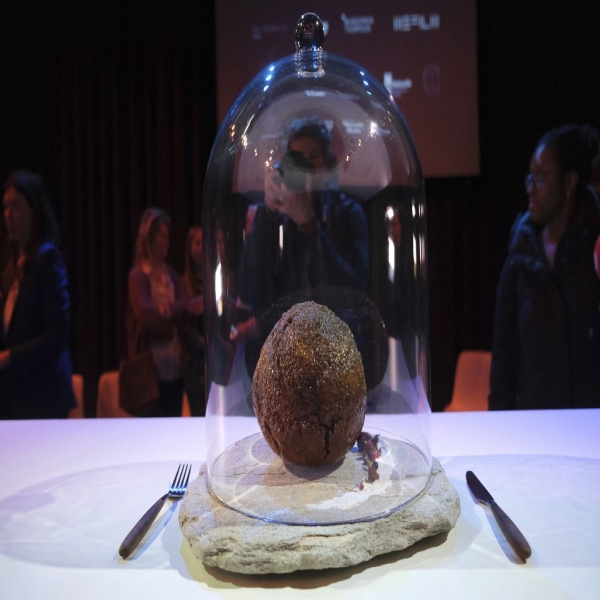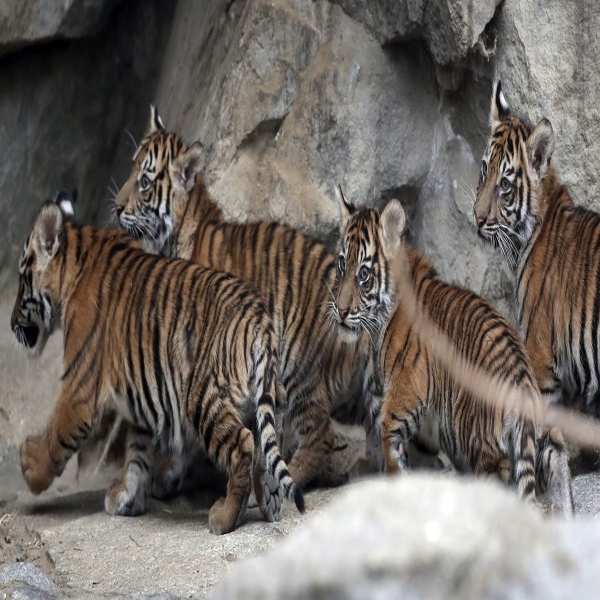“Exotic” cultivated meats claim to be harmless, but they could threaten actual endangered animals.

Jude Whiley is a freelance journalist from London. He has written for the Vegan Society, VeganLife, and Wired, and he’s studying for a PhD in creative writing at the University of East Anglia.
What is the strangest meat you’ve eaten?
For me, it’s reindeer. This was during a trip to Finland when I was 7. We’d gone to the Arctic Circle, where I hoped to meet Father Christmas. I remember being driven through dark forests on the back of a snowmobile to a firelit clearing where we ate reindeer sausages. Though my baby brain didn’t then realize I was eating one of Rudolph’s cousins and that Santa might disapprove, I enjoyed the meat. It was spiced and tender and warmed me after the freezing journey.
Eating reindeer remains one of my core memories, though I now consider eating all animals gross and unethical. But I’ve discovered reindeer is not a very exotic meat, at least compared with what my Instagram followers have been eating. When I posted the question: “What’s the most exotic meat you’ve eaten?” I discovered my followers had eaten everything, from alligator to minke whale.
Which animals we find acceptable to eat vary from person to person, according to our values, palates, and upbringing. Many consider eating cows and chickens okay, but not octopus, dolphin, or tiger. Right now, you’d be hard-pressed to find tiger meat in your local supermarket, but developments in tech are making a future possible in which eating exotic meats, from alligator to zebra, could be commonplace.
But, how? Well, factory-farmed tiger, thankfully, is not about to become a dystopian reality. But we might one day eat “ethical” tiger through innovations in cultured-cell technology.
Cultured meat, also known as cell-cultivated meat, is not pork reared on caviar and Italian neorealist cinema — it is meat that has been grown in a lab. It has the potential to liberate animals from exploitation, creating burgers and sausages from meat that has been grown in bioreactors and harvested without the death of a sentient being. The first cell-cultivated chicken in the US came to market this summer. It’s an exciting technology, as it could substantially reduce the number of animals slaughtered yearly (or, at least, limit the expansion of that number).
It’s not all chicken and pork, though. Recently, startups such as Primeval Foods and Vow have begun developing meat cultured from the cells of exotic (and even extinct) animals, such as tiger, zebra, or mammoth. A gigantic mammoth meatball produced by Vow earlier this year brought many people’s attention to the potential applications of cultured-cell technology, and advocates argue the novelty of nontraditional meats could help win over an otherwise hard-to-reach group of potential consumers.

Some animal advocates, however, have voiced concerns that popularizing exotic meats could have unforeseen consequences. The tech, if successful (a big if), could create an appetite for real tiger meat, putting additional pressure on already-endangered wild big cat populations. And some vegans, who advocate against the commodification of animals, worry that eating cell-cultivated meat could entrench the belief that animals are something to be exploited and consumed, rather than beings to be protected; they argue the desire to manufacture cultured tiger meat reveals that “clean” meat is a fallacy promoted by meat producers developing new ways to exploit the animal kingdom.
How cultured tiger steak could hurt real tigers
In April, I spoke with Yilmaz Bora, CEO of Primeval Foods, a company developing cultured tiger meat. I’d imagined Bora to be a meat-lover, but I was surprised to discover that he was the opposite.
“I went vegan roughly three, four years ago,” Bora said. “It started with activism, supporting UK [animal rights] groups. After a while, I realized that was not going to work. We had to involve the economy, involve the capitalist system, to have a meaningful impact on animals.”
From there, Bora began developing alternative proteins that he hoped would convert diehard meat eaters from factory-farmed animals. According to Bora, exotic meat seemed a viable option because, he believes, the “masculine” group that drives meat consumption would find meat grown from big cats more compelling than meat grown from conventional livestock cells.
“If you are making barbecue every weekend in Texas and you have no interest in climate, no interest in animal welfare, there is not any product for you,” he said. “Tigers, or other wild cats such as lions, represent power. … There is this masculine profile [that is firmly anti-vegan], and they tend to not eat alternative plant-based or alternative protein on the market, but it will appeal to them because it represents something luxury.”
Developing meat from the cells of an animal that represents power might be a compelling method of marketing cultured meats. But problems will arise if the appetite for lab-grown tiger causes an upsurge in demand for meat from wild tiger populations. Only 4,500 tigers remain in the wild. John Goodrich, of the big cat conservation charity Panthera, explained the potential complications cultured tiger meat could create for tiger conservation.
“One of the biggest threats to big cats, especially tigers, is poaching for their body parts, primarily for use in traditional Chinese medicine,” Goodrich said. “You’d hope that [cultivated meat] would flood the market so that there would no longer be any market for wild tiger parts.”
It’s not at all clear that this would happen, even if cultivated tiger meat did become a success. “My concern is that there’s always going to be the contingent that wants the real thing,” Goodrich added. “By mainstreaming it, you are creating this much, much bigger market for tiger parts. … Let’s say your market is a billion people: If less than 1 percent of that wants the real thing, that’s still enough to put tremendous pressure on the remaining 4,500 tigers in the wild.”
“It’s not worth the risk,” he concludes.

When I put this to Bora, I was met with a confusing response. He said he was “not aware” of the market for tiger in China, and added that he believed people would not consume wild tiger because sourcing it “is not convenient” and “it will taste really really bad … because they are very muscular animals, they move a lot … they have little to no fat.”
Cultivated meat technology, Bora added, allows Primeval Foods “to change the fat percentage on the end product. … We can do whatever we want to have that better mouthfeel, better texture, better taste.”
That’s fine, but, as Goodrich explained, what if even a small contingent of Primeval Foods’s future intended consumers decide they want to eat real tiger? With wild tiger populations dwindling, any increase in poaching would be catastrophic, and the fact that real tiger meat “tastes really really bad” can only be discovered after the animal has been slaughtered.
It’s hard to fathom that degree of ignorance from the CEO of a startup with potentially harmful environmental implications — especially since others in the industry have engaged with such concerns more deliberately. When I spoke to George Peppou, founder of Vow, he said that, in the preliminary stages of developing Vow’s cultured cell products, Vow “started to work with the Zoo and Aquarium Association in Australia,” who “scared the crap out of me about … unintentionally stimulating wildlife crime.”
Ultimately, the product that Vow aspires to bring to market is not mammoth or other exotic animals, but what Peppou describes as “the Cheerios of meat” — synthetic, branded meats made from combining different animals’ cell lines in a way that’s comparable to the mixing of oats, wheat, and barley to create breakfast cereals. This would avoid problems like stimulating wildlife crime, as the meat Vow takes to market cannot be traced to a single species.
Vow’s cultivated mammoth, according to Peppou, is a stunt intended to “challenge people’s perception of what meat is and get them comfortable with the idea that it can look different to what we have available to us now.”
The mammoth meatball was developed, Peppou explained, after the company asked itself the question, “How do we move the window of what’s acceptable in meat?” Right now, synthetic “chimera meats” seem strange, and many consumers would choose chicken over lab-grown hybrids. Making synthetic meats seem conventional — at least compared to mammoth meatballs — is the strategic goal of Vow’s stunt.
The philosophical trouble with tiger and all cultivated meat
While Vow is embracing exotic cultivated meats with an eye toward preventing knock-on effects like further harming endangered species, there are also broader philosophical questions about cultured meats, whether conventional, exotic, or extinct, that are worth considering.
John Sanbonmatsu, an animal rights philosopher and professor at the Worcester Polytechnic Institute in Massachusetts, argues that cultivated meat only entrenches the commodification of animals and the idea that it’s okay to consume their flesh.
The development of tiger steaks by Primeval, he said, is “fundamentally disrespectful of their personhood.”
“One of the major problems with the way we relate to other animals is we treat them as commodities,” Sanbonmatsu told me. “If you look at the discourse of Primeval Foods or these other companies, the way they describe the rationale for their enterprise is reinforcing the idea that humans are meant to exploit nature and other animals for their purposes without any ethical limits.”
To Sanbonmatsu’s thinking, the assumption that animals are available for exploitation is only underscored by the development of exotic cultivated meat. Viewed through that lens, growing tiger meat is just another example of humanity’s disregard for the animal kingdom, demonstrating that the drive to find “ethical” ways to exploit them creates fresh problems that need solving further down the line.
For example, Sanbonmatsu and charities such as Food & Water Watch argue that because lab-grown meat doesn’t challenge the idea that animal flesh is edible, it will augment rather than replace factory farming. As the market for meat increases around the world, they predict, there could simply be no reduction in the number of animals currently slaughtered yearly (tens of billions of land animals and hundreds of millions or even trillions of fish). Rather, cultivated meat could merely limit the expansion of this number. While this is arguably a good thing, insofar as one dead cow is better than two, animal slaughter will continue to be a massive, cruel industry with an immense environmental impact.
Those ethical concerns bring up an underlying question animal rights advocates will have to confront: What does it take for meat to be “clean?” For vegans such as Sanbonmatsu, who believe in animal personhood and the absolute equality of animals and humans, there is no scenario where that is the case.
For others, the cleanest cultivated meat would be a product created without harming animals at all, but even this is proving to be a quixotic goal, as cultivated meat companies struggle to make their products without animal-derived ingredients. Cultivated meat companies are also taking funding from conventional meat companies like Tyson and Cargill, some of the world’s biggest perpetrators of animal suffering.
It might still be that the current fastest way to dramatically limit animal suffering is through embracing cultured meat companies while putting the total abolition of animal exploitation on the back burner.
Deeper ethical questions aside, it is undeniable that some advocates, such as Bora, are working to develop cultivated meat with the aspiration, however unlikely, of ending factory farming and conventional meat consumption. All I ask is that they confront the potential implications of the tech: Developing cultivated tiger, mammoth, or anything else might be a cool way to draw attention to cultured-meat technology, and it could succeed in drawing new consumers. But if people decide they want to eat “the real thing,” then many wild animals, from tigers to elephants to lions, could go the way of the woolly mammoth.
Source: vox.com






